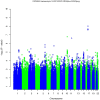Common genetic determinants of intraocular pressure and primary open-angle glaucoma
- PMID: 22570627
- PMCID: PMC3342933
- DOI: 10.1371/journal.pgen.1002611
Common genetic determinants of intraocular pressure and primary open-angle glaucoma
Abstract
Intraocular pressure (IOP) is a highly heritable risk factor for primary open-angle glaucoma and is the only target for current glaucoma therapy. The genetic factors which determine IOP are largely unknown. We performed a genome-wide association study for IOP in 11,972 participants from 4 independent population-based studies in The Netherlands. We replicated our findings in 7,482 participants from 4 additional cohorts from the UK, Australia, Canada, and the Wellcome Trust Case-Control Consortium 2/Blue Mountains Eye Study. IOP was significantly associated with rs11656696, located in GAS7 at 17p13.1 (p=1.4×10(-8)), and with rs7555523, located in TMCO1 at 1q24.1 (p=1.6×10(-8)). In a meta-analysis of 4 case-control studies (total N = 1,432 glaucoma cases), both variants also showed evidence for association with glaucoma (p=2.4×10(-2) for rs11656696 and p=9.1×10(-4) for rs7555523). GAS7 and TMCO1 are highly expressed in the ciliary body and trabecular meshwork as well as in the lamina cribrosa, optic nerve, and retina. Both genes functionally interact with known glaucoma disease genes. These data suggest that we have identified two clinically relevant genes involved in IOP regulation.
Conflict of interest statement
The authors have declared that no competing interests exist.
Figures





References
-
- van Koolwijk LME, Bunce C, Viswanathan AC. Genetic Epidemiology. In: Shaarawy TM, Sherwood MB, Hitchings RA, Crowston JG, editors. Glaucoma. Saunders Elsevier; 2009. pp. 277–289.
-
- Monemi S, Spaeth G, DaSilva A, Popinchalk S, Ilitchev E, et al. Identification of a novel adult-onset primary open-angle glaucoma (POAG) gene on 5q22.1. Hum Mol Genet. 2005:725–733. - PubMed
-
- Rezaie T, Child A, Hitchings R, Brice G, Miller L, et al. Adult-onset primary open-angle glaucoma caused by mutations in optineurin. Science. 2002:1077–1079. - PubMed
-
- Stone EM, Fingert JH, Alward WL, Nguyen TD, Polansky JR, et al. Identification of a gene that causes primary open angle glaucoma. Science. 1997:668–670. - PubMed
Publication types
MeSH terms
Substances
Grants and funding
LinkOut - more resources
Full Text Sources
Medical
Molecular Biology Databases

